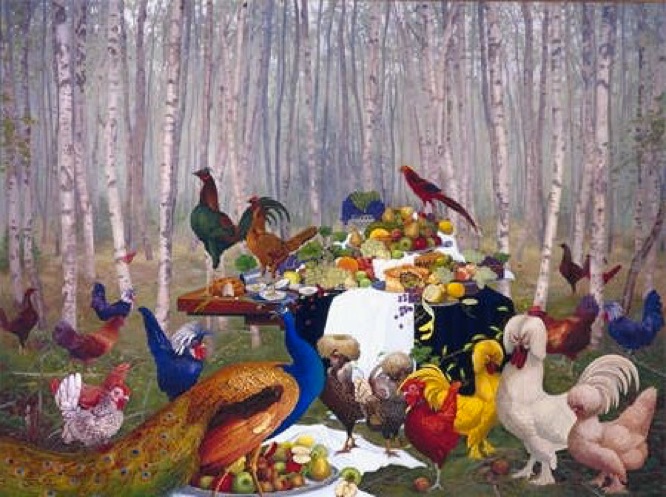Scott paints “Penny“ for your thoughts
Cincinnati artist gets Santa Fe Show
By Owen Findsen The Cincinnati Enquirer
A flock of poultry has invaded the paintings of Michael Scott, and they’re causing a flutter in Santa Fe, N.M.
He’s calling this fowl work Penny’s Grand Vision A Creation Story. It’s a series of 25 paintings and an accompanying book/catalog. The Paintings serve as illustrations for the story.
Mr. Scott is a Cincinnati painter known for his dramatic landscapes. Now he’s switched to still lifes, or rather un-still lifes. The paintings are filled with flying food, prancing chickens and a peacock named Penny. She is the star of a cast of barnyard characters that includes Mr. Rex and Mrs. Emma Tuffy, Dr. Ming Fowl, Thurston Longtail and a score of others.
The characters flutter through the paintings, each of which is a chapter in the very convoluted fairy tale. “It’s Mother Goose for adults“, explains Gayle Maxon-Edgerton, director of contemporary art at the Gerald Peters Gallery in Santa Fe, where the paintings are on exhibit. “It’s very different kind of art for Santa Fe.“ She says. “But everyone who has seen it is delighted by it. They come in and they just chuckle“
This fowl project began when Mr. Scott got up one morning and saw a peacock wandering around his yard. “ I took it as an omen,“ says the artist, who lives on a wooded hillside in New Richmond.
He began making drawings of the bird and soon was collecting other birds to serve as models and inspiration for his art. “ I have 24 roosters and chickens, two peacocks, two pheasants and four doves, he says.
The birds became Mr. Scott’s vehicle for commenting on the state of the art of painting at the end of the millennium. Viewers who know the history of painting will spot all kinds of references to specific artists and styles.
“My work has been so serious for so long that I thought it was time to have some fun,“ Mr. Scott says. “I hope that this work will empower people who feel intimidated by art museums and galleries.“
Penny’s quest is to rearrange every still life she sees.
Dutch still lifes from the 17th century are the starting point, because many of them include images of dead fowl among the foods. Chickens, ducks and geese, dressed for dinner, are hung or laid out among fruit, vegetables and wine, all painted in an extremely realistic manner
Penny saw such still lifes at the Metropolitan Museum of Art in New York when she was a mere chick. “Penny really does find it rather bad that so many of her dear friends, maybe even her relatives, have come to a grisly end draped over a picturesque kitchen table surrounded with sparkling glass, lush fruits and their own gore,“ Mr. Scott writes.
New Plan
Penny devises a plot to rearrange all the still lifes in museums. She invites all her friends To a banquet to enlist them in her plan. Her mission is opposed by a mysterious organization know as TRA (Twisted Ridiculous Art), which is art spelled backward. “They are not labeled as such, but it is probably suspect that they are curatorial types,“ Mr. Scott says. Birds with brilliant plumage fill every canvas, strutting around tableaus of colorful arrangements of food and flowers. In many of the works food-grapes, pickles, lemons, jalapeno flavored candy corn-flies through the air. Curators, Mr. Scott says, tell other people how to look at art and what to think about it, but he is “trying to suggest an approach that allows people to go into galleries and museums to discover their own creativity in interpreting art.“.
The symbolism is difficult to explain in a nutshell, or even an eggshell. In the 20th-century, artist have tried to invent new art by abandoning the ideas of the past. Most frequently abandoned is technical proficiency. Curators praise artists who draw a single line on an otherwise blank canvas, and they demean artists who paint detailed paintings. Andrew Wyeth for instance, is dismissed by much of art officialdom as a hack.
But as the millennium approaches, many artists are dashing to rehash the past, as if they were the first to discover the work of artists such as Rembrandt. Mr. Scott is a realist and a post-modern artist. He understands the motivation of today’s artists as well as the absurdity of some of that motivation. His richly colorful paintings are filled with symbolism about science, art and spirituality. Students of art history may know that the egg that hangs from a string in one painting first appeared in a 15th century painting of the Madonna by Piero della Francesca. Or that the image of an imprisoned rooster more than hints at the 19th century super-real still lifes of American painter William Harnett.
Serious readers may perceive the creative futility of Penny Peacock, a flightless bird who, as a male, is incapable of laying eggs. (“Penny is a very confused girl“, Mr. Scott says when reminded that peacocks are male. “She’s not a girl at all, but a transvestite pullet.“)
“You don’t have to know any of that to enjoy Michael’s work,“ Ms. Maxon-Edgerton says. “You can enter into it at any level, but there’s plenty there to mull over; layers and layers of meaning; plenty of allegory. And there are the puns.“ Art destination Mr. Scott is “tickled“ that the story is being told at the Gerald Peters Gallery. “Santa Fe is the third largest art market in the nation, and it really is an art destination. People go to Santa Fe to buy art, “Mr. Scott says.

